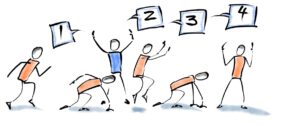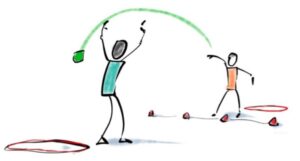Get lesson 1 of all sports: Sign up for a free pe planning membership
Tennis
Learning Objectives
- Show control of a ball with basic actions.
- Use the correct skills to meet the challenges.
Curriculum information
Literacy Keywords
- Underarm
- Score
- Explore the game
- Experiment
- Aiming
- Opposition
- Throw
- Tactics
Citizenship
- Develop own experiences and ideas
Numeracy
- Keep score of the game
Equipment
- Tennis balls
- Marker cones
- Hoops
- Beanbags
Risk Assessment
- Suitable clothing and footwear worn by participants.
- Equipment suitable for participants, safe and checked.
- Area safe and checked - any hazards removed.
- Safety information highlighted to participants.
- Staff aware of all emergency procedures, including designated 1st aider.
Knowledge Checks
Throughout this plan you will see ‘Knowledge Checks’ to help you ensure the pupils are acquiring the intended knowledge as the lesson progresses. The two types of knowledge to focus on in PE are:
- Declarative Knowledge: Factual knowledge concerning movement, rules, tactics, strategies, health and participation (best practiced through spoken or written observations of a practical demonstration).
- Procedural Knowledge: Knowing how to apply declarative facts (best practiced through demonstration or participation).
Teacher Notes
- This is the first lesson in the Tennis Unit of Work.
- The intention of the lesson is to introduce the children to the new topic. It gives them the opportunity to experience the game and explore the skills they will be learning and developing in the unit.
- The main activity within the lesson incorporates many of the skills and tactics that will be covered in the unit.
- Playing the game in this lesson gives you the opportunity to make an initial assessment of your class. By observing the children, you can make a judgement on their current ability and plan your teaching for the rest of the unit accordingly.
- Tennis is a net and wall game. In this unit, children will be introduced to object manipulation, ball control, and using basic tactics in games and activities.
Activities & Games
Number Crazy
5 - 10 mins- Children begin moving around the area on their own. Gradually increase the speed of movement.
- Whilst moving around the area call out numbers for actions they must complete:
– 1 = Touch the floor with one hand.
– 2 = Jump in the air.
– 3 = Touch the floor with two hands.
– 4 = Celebrate scoring a point.

Teaching Points
- Think of different actions you can add
- Head up
- Look where you are going
- Gradually increase speed to increase heart rate
Progression:
- Move in different ways (jumping, skipping, sideways, etc.
Progression:
- Change the actions – the children can help with this.
Circle Catch
5 - 10 mins- Split the class into groups of 5/6 children and give each group 1 beanbag.
- Each group should find a space and form a small circle with one child standing with the ball in the centre.
- The child in the centre can throw the beanbag to any of the children in the circle who must catch it and throw it back to the child in the centre.
- The child in the centre should keep throwing the beanbag to different children.
- Keep changing the child in the centre.

Teaching Points
- Ensure children hold and throw the beanbag like a ball (in the palm of their hand, instead of pinching it to fling).
- Hands ready.
- Watch the beanbag.
- Be ready to receive the beanbag.
- Aim your throw.
- Concentrate.
- Move to get in line with the beanbag.
To make the activity harder:
- Use a ball instead of a beanbag. Make the circle bigger.
To make the activity easier:
- Slide the beanbag across the floor, and receive by placing hands together, in front of the body.
Knowledge Check
- PROCEDURAL KNOWLEDGE: Ask some children to demonstrate the activity/skill.
- DECLARATIVE KNOWLEDGE: Ask other children to describe what is required to perform the task with success.
Tennis Tactics
5 - 10 minsAllow children to play the game, explore and experience the skills needed to play successfully. Encourage them to experiment ways to play the game successfully.
- The game is played 1 v 1 on a small court.
- The aim of the game is to throw beanbags into your opponent’s hoop to score points.
- A dividing line should be set up, with one pupil on each side of the line. A hoop should be placed approximately 3-4 steps from the dividing line (and behind each pupil).
- The children take turns to throw the beanbag from their side of the court into their opponent’s hoop.
- A child is allowed to defend their hoop and stop the beanbag going into their hoop but is not allowed to cross the dividing line, enter or touch the hoop.
- If a child successfully throws the beanbag into their opponent’s hoop, they score 1 point.

Teaching Points
- Introduction to tennis and net/wall games in general.
- Explain the rules and then let the children explore the game for themselves.
- What skills do you need to use? Ask children to think about this as they play the game.
- Experiment with different ideas, skills and tactics.
- How can you score points? Ask the children to think about this as they play the game.
- Observe children whilst playing the game – are they able to play it successfully?
- What areas do you need to focus your teaching on in the rest of the unit?
- Provide advice and guidance if necessary.
Progression:
- Introduce a second hoop. This hoop should be 2 steps to the side of the first hoop. Play the game as before but each child now has two hoops to score in and defend.
Adaptations and variations.
- The game can be made easier for the children by – Using bigger hoops, moving the hoop(s)
- nearer to the dividing line.
- The game can be made harder by – Using cones or marker spots instead of hoops; moving the hoop(s) further away from the dividing line; increasing the gap between hoops if playing with two.
- Play without an opposition to focus on accuracy.
- Play two against two, with three or four
Knowledge Check
- PROCEDURAL KNOWLEDGE: Ask some children to demonstrate the activity/skill.
- DECLARATIVE KNOWLEDGE: Ask other children to describe what is required to perform the task with success.
True or False; Red or Green
3 - 5 mins- Children work inside a large, safe area.
- On one side of the area place a line of green cones; on the opposite side place red cones; and along the middle place a line of red cones.
- Children begin to walk around the area.
- Call out a simple statement regarding tennis.
- If children feel the statement is true they head to the green line; false to the red line; and if they’re unsure they stand on the red line.
- Allow a minute or two for children to move to their colour choice before discussing the statement.
- After the discussion, allow children to change their mind about which colour line they are at.
- Repeat with a few true and false statements.

Teaching Points
- Gradually decrease the movements.
- Example statements could be…
– A ball is used in tennis.
– A net part of the court in tennis.
– Tennis is played in water.
– A tennis ball is the same size as a football.
Knowledge Check
What skills did you use to play the games today?
- Encourage the children to think of what they did when playing the game.
What did you do well today?
- Encourage the children to think of what they did well when playing the games.
Get lesson 1 of all sports: Sign up for a free pe planning membership